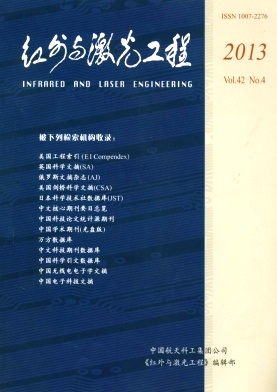|
[1]
|
|
|
[2]
|
Mattern P L, Watkins L M, Skoog C D, et al. The effects of radiation on the absorption and luminescence of fiber optic waveguides and materials[J]. IEEE Transactions on Nuclear Science, 1974, NS-21: 81-95. |
|
[3]
|
Evans B D, Sigel G H, Jr. Permanent and transient radiation induced losses in optical fibers[J]. IEEE Transactions on Nuclear Science, 1974, NS-21: 113-118. |
|
[4]
|
|
|
[5]
|
Golob J E, Lyon P B and Looney L D. Transient radiation effects in low-loss optical waveguides[J]. IEEEE Transactions on Nuclear Science, 1977, NS-24(6): 2164-2168. |
|
[6]
|
|
|
[7]
|
|
|
[8]
|
Friebele E J. Optical fiber waveguide in radiation environments[J]. Optical Engineering, 1979, 18(6): 552-561. |
|
[9]
|
Friebele E J, Lyon P B, Blackburn J, et al. Interlaboratory comparison of radiation-induced attenuation in optical fibers. Part Ш: Transient exposures[J]. IEEE Journal of Lightwave Technology, 1990, 8(6): 977-989. |
|
[10]
|
|
|
[11]
|
Han Yanling, Xiao Wen, Yi Xiaosu, et al. Active recovery effect of irradiation optical fiber[J]. Infrared and Laser Engineering, 2008, 37(1): 128-131. (in Chinese) 韩艳玲, 肖文, 伊小素, 等. 辐照光纤的主动恢复效应[J]. 红外与激光工程, 2008, 37(1): 128-131. |
|
[12]
|
|
|
[13]
|
|
|
[14]
|
Wang Xueqin, Zhang Chunxi, Jin Jing, et al. Radiation-induced attenuation effect on special optical fibers applied in space[J]. Infrared and Laser Engineering, 2011, 40(12): 2516-2520. (in Chinese) 王学勤, 张春熹, 金靖, 等. 空间用特种光纤的辐射致衰减效应. 红外与激光工程, 2011, 40(12): 2516-2520. |
|
[15]
|
Tsunemi Kakuta, Naoki Wakayama, Kazuo Sanada, et al. Radiation resistance characteristics of optical fibers[J]. IEEE Journal of Lightwave Technology, 1986, 4(8): 1139-1143. |
|
[16]
|
|
|
[17]
|
Akira Iino, Junich Tamura. Radiation resistivity in silica optical fibers[J]. IEEE Journal of Lightwave Technology, 1988, 6(2): 145-149. |
|
[18]
|
|
|
[19]
|
Moss C E, Casperson D E, Echave M A, et al. A space fiber-optic X-ray burst detector[J]. IEEE Transactions on Nuclear Science, 1994, 41(4): 1328-1332. |
|
[20]
|
|
|
[21]
|
Deparis O, Mgret P, Decrtou M, et al. Gamma radiation tests potential optical fiber candidates for fibroscopy[J]. IEEE Transactions on Nuclear Science, 1996, 43(6): 3027-3031. |
|
[22]
|
|
|
[23]
|
|
|
[24]
|
Borgermans P, Nol M. Multiple wavelength analysis of radiation-induced attenuation on optical fibers: a novel approach in fiber optic dosimetry[J]. IEEE Transactions on Instrumentation and Measurement, 1998, 47(5): 1255-1258 |
|
[25]
|
Naka R, Watanabe K, Kawarabayashi J, et al. Radiation distribution sensing with normal optical fiber[J]. IEEE Transactions on Nuclear Science, 2001, 48(6): 2348-2351. |
|
[26]
|
|
|
[27]
|
|
|
[28]
|
Klein D M, Yukihara E G, Bulur E, et al. An optical fiber radiation sensor for remote detection of radiological materials[J]. IEEE Sensors Journal, 2005, 5(4): 581-588. |
|
[29]
|
|
|
[30]
|
Liu Songhao, Li Chunfei. Optoelectronic Technology and Application[M]. Guangzhou, Hefei: Guangdong Science and Technology Press, Anhui Science and Technology Press, 2006: 800-801. (in Chinese) 刘颂豪, 李淳飞. 光电子学技术与应用[M]. 广州, 合肥: 广东科技出版社, 安徽科学技术出版社, 2006: 800-801. |
|
[31]
|
Liao Yanbiao. Fiber Optics[M]. Beijing: Tsinghua University Press, 1998: 54-91. (in Chinese) 廖延彪. 光纤光学[M]. 北京: 清华大学出版社, 1998: 54-91. |
|
[32]
|
|
|
[33]
|
|
|
[34]
|
Mei Zhenyue. Nuclear Physics[M]. Beijing: Science Press, 1966: 1-36. 梅镇岳. 原子核物理学[M]. 北京: 科学出版社, 1966: 1-36. |
|
[35]
|
|
|
[36]
|
Fudan University, Tsinghua University and Peking University. Nuclear Physics Experimental Methods[M]. Beijing: Atomic Energy Press, 1981: 36-72. (in Chinese) 复旦大学, 清华大学, 北京大学合编. 原子核物理实验方法[M]. 北京: 原子能出版社, 1981: 36-72. |
|
[37]
|
Yasuo Kokubun. Lightwave Engineering[M]. Beijing: Science Press, 2002, 131-136. (in Chinese) 国分泰雄, 光波工程. 北京: 科学出版社, 2002, 131-136. |









 DownLoad:
DownLoad: